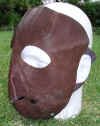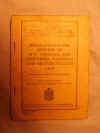| |
|
|
|
 |
 |
 |
 |
| Wool-lined
Leather Jerkin
|
Leather Jerkin
|
Normandy
2006 |
Normandy
2006 |
| |
|
|
|
|
The Leather Jerkin dates back to the first world war and was essentially a
cold-weather "working" item. Most WW2-era jerkins are made from brown
leather, with 4 large plastic
buttons on the front, and lined throughout in khaki serge.
Many jerkins appear of "patchwork" construction, likely due to
wartime economies requiring the use of the smallest scraps of leather.
The common brown leather colour may vary from a very light orange-tan
right through to a dark brown. Jerkins came in 3 main sizes, marked "1 to 3"
(smallest to largest).
British WD jerkins can still be found today brand-new, but they are
getting scarcer and the price seems to be rising. Loads of them were
released from storage in the early 1990's. A "used" example
is probably a better bet, especially if you intend to wear it.
|
| |
|
|
|
 |
 |
 |
 |
| Fibre
helmet |
Fibre
helmet |
Steel helmet |
Steel helmet |
| |
|
|
|
| Commonly termed the
"fibre" or "pulp" helmet, or even "pudding basin", this helmet type preceded the steel motorcyclist's helmet by approximately 2
years. The WD issue fibre helmet was introduced into service in the late 1940. A later, 2nd model of this helmet was produced which
economized on production methods and materials. Introduced in 1941, this
"economy" helmet had the shell constructed from a compressed
rag/cork/rubber mix which additionally did not feature the external
anti-abrasion strips either side of the lining attachment cord.
Internally, the cotton-tape head cradle was replaced with strips of
reinforced oil-cloth/rexine. |
| |
|
|
|
| The British WW2 1942-pattern Motorcyclist's Steel Helmet was made in quite a range of
sizes, from 6 1/4 through to 7 3/4, going up in 1/4 size increments.
Two sizes of steel shell were made for all sizes, the smallest size for sizes 6 1/4 through to 7 1/4, and the largest size for the two remaining sizes 7 1/2 and 7 3/4.
The helmet was made from 1942 until 1945 in quantity, and the lining solely by
"Briggs Motor Bodies" (BMB) of Dagenham, Essex. Helmets made from 1942 until 1944 are usually finished in drab
khaki-green, and from 1944 onwards finished in drab dark brown.
|
| |
|
|
|
 |
 |
 |
 |
| ORs
Service Dress Cap |
Field
Service Cap |
Coloured
Field Service Cap |
General
Service Cap |
| |
|
|
|
| The
Other Ranks Service Dress Cap was officially retained in wartime
only by the Guards and the Military Police, but photographs show
occasional exceptions to this rule. It is worn here with motoring goggles.
The
field Service Cap specified in 1937 to be worn with the battledress was
replaced in 1943 by the Generals Service Cap. The (Signals) Coloured Field
Service Cap which colours were consistent with the corps traditions had in
most cases the came cut as the normal Field Service Cap. Wearing Coloured
Field Service Caps was allowed from June 1937, but was optional and in any
case reserved to personnel on leave and below the rank of Colonel. The
Coloured Fields Service Cap could only be purchased privately.
|
| |
|
|
|
 |
 |
 |
|
| Goggles |
Goggles
boxed |
Goggles |
|
| |
|
|
|
 |
 |
 |
 |
| Battle
dress blouse |
ORs
flannel shirt |
Battle
dress trousers |
Pantaloons |
| |
|
|
|
 |
 |
 |
 |
| Jacket
rubber proofed |
Jacket
rubber proofed |
Leggings
rubberprooved |
Leggings
rubberprooved |
| |
|
|
|
 |
 |
|
|
| Coat
rubber proofed |
Coat
rubber proofed |
|
|
| |
|
|
|
 |
 |
 |
|
|
Gauntlets |
Gauntlets |
Gauntlets 1943 |
|
| |
|
|
|
| DR
Gauntlets pre-dated WW2, and comprised a stout leather glove with a cotton-fleece lined hand portion to which was affixed the stiffened leather cuff section to prevent wind and rain from entering the coat
sleeves.
The original gloves were commonly found in a shade of "buff" coloured
leather, but variations may be found in literally every shade from near
"off-white" through "tan", to "chocolate
brown", there is no "correct" shade.
The gloves are usually ink-stamped internally on the cuff-portion, with
size, maker, date and WD stamps.
Variations of the gloves can be found, with some versions having the luxury of a tightening strap around the
wrist. |
| |
|
|
|
 |
 |
|
|
| Ankle
boots |
Anklets |
|
|
| |
|
|
|
 |
 |
 |
|
| Three
strap boots |
Socks |
Hose
tops |
|
| |
|
|
|
| Often, you see a DR wearing
pantaloons, tall DR boots, and what appear to be long socks turned down over the boot tops. These "long socks" are
often "hose tops" rather than socks. The standard ensemble was to put on your DR breeches, then your standard grey-wool calf-length woolen Army-issue socks. You then slipped on a pair of khaki-woollen knitted "hose
tops". Hose tops are basically knitted "tubes" or socks, but without the foot
portion. |
| |
|
|
|
 |
 |
 |
|
| Officer's
haversack |
Map
case |
Gas
mask |
|
| |
|
|
|
 |
 |
|
|
| Facemask |
Facemask |
|
|
| |
|
|
|
 |
 |
 |
 |
| Webly
& Scott revolver |
|
|
|
| |
|
|
|
 |
 |
|
|
| |
|
|
|
|
|
|
|

